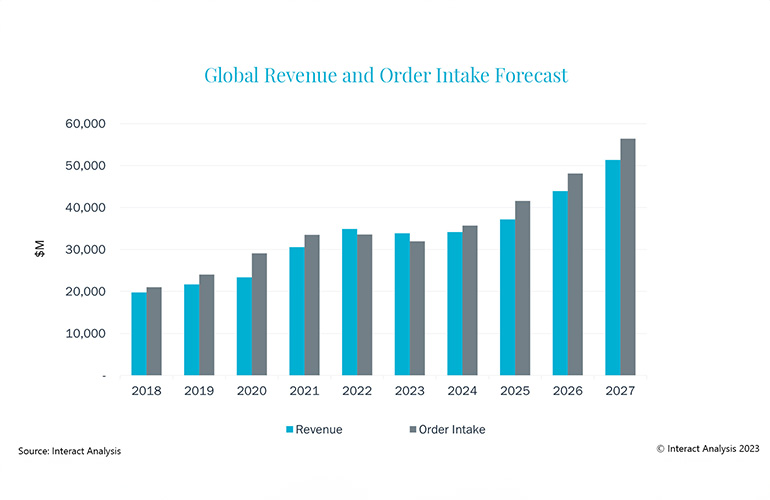|
Listen to this article  |

Following a slowdown in revenues in 2023, the global warehouse automation market could experience some growth in 2024 and return to high growth in 2025. | Credit: Interact Analysis
According to a recent study conducted by market intelligence firm Interact Analysis, the demand for warehouse automation will start to increase again in 2024 following a challenging year in 2023, albeit at a minimal growth rate.
Interact Analysis also projected that revenues from warehouse automation will rise in 2024 and subsequently experience a resurgence in double-digit growth rates starting in 2025.
Due to the pandemic and historically low interest rates in 2019 and 2020, there was a notable rise in e-commerce orders, it said. This, in turn, resulted in a surge in the construction of warehouses and a upswing in sales of warehouse automation.
Warehouses to overcome post-pandemic e-commerce slump
Since then, a deceleration of e-commerce sales and the increase in interest rates has led to a decrease in warehouse construction and a slowdown in investments in warehouse automation, reported Interact Analysis. The order intake for fixed automation is projected to decrease by approximately 8% in 2023.
However, the order intake for mobile automation is anticipated to increase by 38% during the same period. This serves as a safeguard against the overall market decline, noted the market research firm.
The deceleration is primarily affecting vertical markets that have significant reliance on e-commerce, such as general merchandise, grocery, and apparel. These are commonly known as downstream verticals because of their position in the supply chain, closer to the consumer.
Conversely, industries such as durable manufacturing have shown relatively strong performance due to the increasing preference for near-shoring and the construction of factories in the U.S. and Europe. Interact Analysis projected that the durable manufacturing sector will experience the highest growth in warehouse automation among all vertical markets in 2023, with a revenue increase of 6%.
“The rise and fall of warehouse construction has led to a corresponding increase and decrease of end-to-end warehouse automation solutions,” commented Rueben Scriven, research manager at Interact Analysis. “Greenfield sites are well suited for large and complex end-to-end solutions, while brownfield sites are better suited to smaller point solutions that automate particular workflows, such as mobile robots.”
“Because the share of brownfield sites has now increased, the share of point solutions (relative to end-to-end solutions) has also increased,” he wrote. “Therefore, automation vendors that can provide solutions for brownfield sites and distribution center automation projects will fare well in the short term.”
Scriven went on to say: “Although we expect interest rates to remain high next year, warehouse construction will increase and result in an uptick in warehouse automation order intake in the latter half of 2024 and into 2025.”
In May, Scriven predicted that 26% of warehouses would be automated by 2027, an increase from 14% a decade earlier.
Interact Analysis provides methodology
Interact Analysis said the 5th edition of the Warehouse Automation report “provides a comprehensive and detailed analysis of the market.” The market research firm spent months conducting more than 100 interviews and analyzed more than 120 companies. It said it looked specifically at their past, present, and future investments in warehouse automation.
The report is available in a standard and a premium version. The premium version contains a midyear update to adjust forecasts made in the standard version, six months after initial release. It also contains access to product news and financial databases to reduce efforts spent by internal marketing teams in collecting this data themselves.
Also included is a “Warehouse Automation Services” Excel sheet, which breaks out the after-sale services and provides forecasts for the different services.
Interact Analysis also recently released a report on software including warehouse control systems (WCS) and warehouse execution systems (WES) in 2024. It also predicted that the market for robotic picking will grow to $6.8 billion by 2030.
Credit: Source link


Comments are closed.